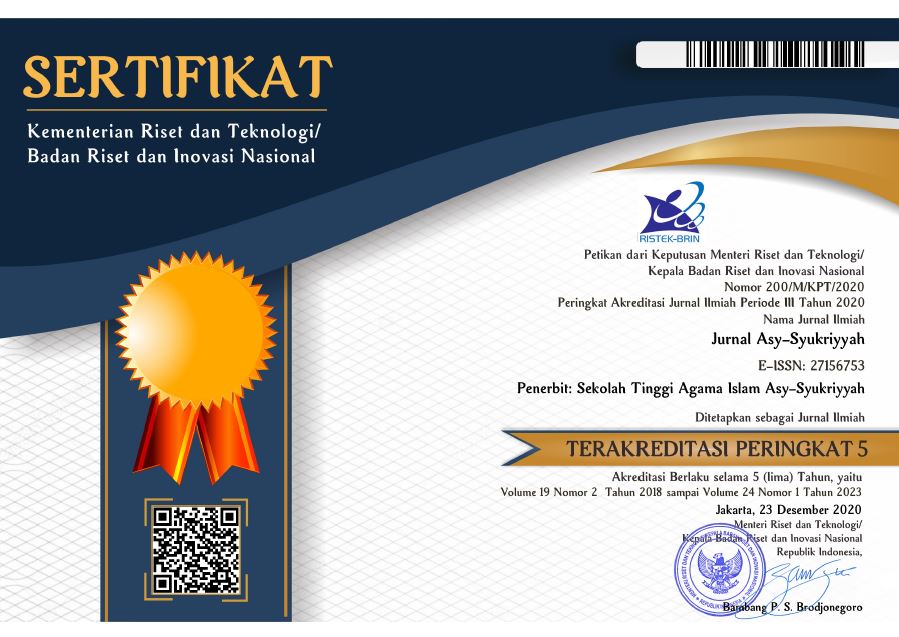ARABIC LANGUAGE LEARNING AT INSTITUTIONS FOR NON-ISLAMIC EDUCATION STUDY PROGRAMS
DOI:
https://doi.org/10.36769/asy.v25i1.424Keywords:
Arabic Language Learning, Institutions, Non-Islamic Education Study ProgramsAbstract
The development of Arabic language skills mostly targets Muslim communities. However, there are specific obstacles to the acquisition of these language skills in higher education institutions, which largely arise from the need to accommodate students of various religious affiliations in their studies. The aim of this research is to reveal the benefits, weaknesses, prospective benefits, and potential drawbacks of incorporating Arabic into the curriculum of higher education institutions. This research uses qualitative methods and combines data from students, lecturers and policy documents related to curriculum development. Before reaching a conclusion, the data obtained is categorized, displayed and examined. Findings show that these institutions have valuable assets such as skilled Arabic lecturers and dedicated language and study facilities. However, the shortcomings of this institution stem from the lack of linguistic skills of teachers in several disciplines, namely the sharia economics study program and Islamic family law.
References
Adeeb, O F A. “Arabic Text Steganography Based on Deep Learning Methods.” IEEE Access 10 (2022): 94403–16. https://doi.org/10.1109/ACCESS.2022.3201019.
Alali, M. “Multitasking Learning Model Based on Hierarchical Attention Network for Arabic Sentiment Analysis Classification.” Electronics (Switzerland) 11, no. 8 (2022). https://doi.org/10.3390/electronics11081193.
Albukhitan, S. “Framework of Semantic Annotation of Arabic Document Using Deep Learning.” Procedia Computer Science, 2020. https://doi.org/10.1016/j.procs.2020.03.096.
Aldjanabi, W. “Arabic Offensive and Hate Speech Detection Using a Cross-Corpora Multi-Task Learning Model.” Informatics 8, no. 4 (2021). https://doi.org/10.3390/informatics8040069.
Ali, Z. “Understand My World: An Interactive App for Children Learning Arabic Vocabulary.” IEEE Global Engineering Education Conference, EDUCON, 2021. https://doi.org/10.1109/EDUCON46332.2021.9454114.
Almisreb, A A. “Arabic Handwriting Classification Using Deep Transfer Learning Techniques.” Pertanika Journal of Science and Technology 30, no. 1 (2022): 641–54. https://doi.org/10.47836/PJST.30.1.35.
Almuzaini, H A. “Impact of Stemming and Word Embedding on Deep Learning-Based Arabic Text Categorization.” IEEE Access 8 (2020): 127913–28. https://doi.org/10.1109/ACCESS.2020.3009217.
Alwehaibi, A. “A Study of the Performance of Embedding Methods for Arabic Short-Text Sentiment Analysis Using Deep Learning Approaches.” Journal of King Saud University - Computer and Information Sciences 34, no. 8 (2022): 6140–49. https://doi.org/10.1016/j.jksuci.2021.07.011.
Alzyout, M. “Sentiment Analysis of Arabic Tweets about Violence against Women Using Machine Learning.” 2021 12th International Conference on Information and Communication Systems, ICICS 2021, 2021. https://doi.org/10.1109/ICICS52457.2021.9464600.
Bensoltane, R. “Towards Arabic Aspect-Based Sentiment Analysis: A Transfer Learning-Based Approach.” Social Network Analysis and Mining 12, no. 1 (2022). https://doi.org/10.1007/s13278-021-00794-4.
Boudad, N. “Exploring the Use of Word Embedding and Deep Learning in Arabic Sentiment Analysis.” Advances in Intelligent Systems and Computing, 2020. https://doi.org/10.1007/978-3-030-36674-2_26.
Duwairi, R. “A Deep Learning Framework for Automatic Detection of Hate Speech Embedded in Arabic Tweets.” Arabian Journal for Science and Engineering 46, no. 4 (2021): 4001–14. https://doi.org/10.1007/s13369-021-05383-3.
Duwairi, R M. “Automatic Recognition of Arabic Alphabets Sign Language Using Deep Learning.” International Journal of Electrical and Computer Engineering 12, no. 3 (2022): 2996–3004. https://doi.org/10.11591/ijece.v12i3.pp2996-3004.
ELAffendi, M A. “A Simple Galois Power-of-Two Real Time Embedding Scheme for Performing Arabic Morphology Deep Learning Tasks.” Egyptian Informatics Journal 22, no. 1 (2021): 35–43. https://doi.org/10.1016/j.eij.2020.03.002.
Elfaik, H. “Combining Context-Aware Embeddings and an Attentional Deep Learning Model for Arabic Affect Analysis on Twitter.” IEEE Access 9 (2021): 111214–30. https://doi.org/10.1109/ACCESS.2021.3102087.
Elleuch, M. “Convolutional Deep Learning Network for Handwritten Arabic Script Recognition.” Advances in Intelligent Systems and Computing, 2021. https://doi.org/10.1007/978-3-030-49336-3_11.
Emam, M M. “Screening for Learning Disabilities in Oman: Confirmatory Factor Analysis of the Arabic Version of the Learning Disabilities Diagnostic Inventory.” International Journal of Developmental Disabilities 67, no. 6 (2021): 435–45. https://doi.org/10.1080/20473869.2019.1683367.
Fadel, A S. “Arabic Aspect Extraction Based on Stacked Contextualized Embedding With Deep Learning.” IEEE Access 10 (2022): 30526–35. https://doi.org/10.1109/ACCESS.2022.3159252.
Georgiou, G P. “Vowel Learning in Diglossic Settings: Evidence from Arabic-Greek Learners.” International Journal of Bilingualism 25, no. 1 (2021): 135–50. https://doi.org/10.1177/1367006920945396.
Hasasneh, A. “Arabic Sign Language Characters Recognition Based on a Deep Learning Approach and a Simple Linear Classifier.” Jordanian Journal of Computers and Information Technology 6, no. 3 (2020): 281–90. https://doi.org/10.5455/jjcit.71-1587943974.
Madhfar, M A H. “Effective Deep Learning Models for Automatic Diacritization of Arabic Text.” IEEE Access 9 (2021): 273–88. https://doi.org/10.1109/ACCESS.2020.3041676.
Mohdeb, D. “Evaluating Transfer Learning Approach for Detecting Arabic Anti-Refugee/Migrant Speech on Social Media.” Aslib Journal of Information Management, 2022. https://doi.org/10.1108/AJIM-10-2021-0293.
Muaad, A Y. “Arcar: A Novel Deep Learning Computer-Aided Recognition for Character-Level Arabic Text Representation and Recognition.” Algorithms 14, no. 7 (2021). https://doi.org/10.3390/a14070216.
Mustafa, M E. “A Deep Learning Approach for Handwritten Arabic Names Recognition.” International Journal of Advanced Computer Science and Applications 11, no. 1 (2020): 678–82. https://doi.org/10.14569/ijacsa.2020.0110183.
Nerabie, A M. “The Impact of Arabic Part of Speech Tagging on Sentiment Analysis: A New Corpus and Deep Learning Approach.” Procedia Computer Science, 2021. https://doi.org/10.1016/j.procs.2021.03.026.
Omar, A. “An Evaluation of the Localization Quality of the Arabic Versions of Learning Management Systems.” International Journal of Advanced Computer Science and Applications 12, no. 2 (2021): 443–49. https://doi.org/10.14569/IJACSA.2021.0120256.
Rahal, N. “Deep Sparse Auto-Encoder Features Learning for Arabic Text Recognition.” IEEE Access 9 (2021): 18569–84. https://doi.org/10.1109/ACCESS.2021.3053618.
Ritonga, M. “Arabic Language Learning Reconstruction as a Response to Strengthen Al-Islam Studies at Higher Education.” International Journal of Evaluation and Research in Education 10, no. 1 (2021): 355–63. https://doi.org/10.11591/ijere.v10i1.20747.
Tarmom, T. “Compression versus Traditional Machine Learning Classifiers to Detect Code-Switching in Varieties and Dialects: Arabic as a Case Study.” Natural Language Engineering 26, no. 6 (2020): 663–76. https://doi.org/10.1017/S135132492000011X.
Thaher, T. “Intelligent Detection of False Information in Arabic Tweets Utilizing Hybrid Harris Hawks Based Feature Selection and Machine Learning Models.” Symmetry 13, no. 4 (2021). https://doi.org/10.3390/sym13040556.
Wahdan, A. “A Systematic Review of Text Classification Research Based on Deep Learning Models in Arabic Language.” International Journal of Electrical and Computer Engineering 10, no. 6 (2020): 6629–43. https://doi.org/10.11591/IJECE.V10I6.PP6629-6643.
Zurqoni. “Has Arabic Language Learning Been Successfully Implemented?” International Journal of Instruction 13, no. 4 (2020): 715–30. https://doi.org/10.29333/iji.2020.13444a.
Downloads
Published
How to Cite
Issue
Section
License
Copyright (c) 2024 Mustolikh Khabibul Umam, Daluti Delimanugari, Ana Dwi Wahyuni, Ike Hilatun Nisa

This work is licensed under a Creative Commons Attribution 4.0 International License.















